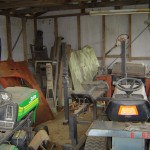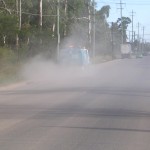
Councillor Peter Harle JP
I have lodged a Notice of Motion for the next Council meeting on the 30th September with regards to Air Quality surrounding the approved Moorebank Concrete Recycling Plant by the NSW State Governments Planning Assessment Commission – PAC.
Details of the “Notice of Motion” for the Council Meeting of 30th September 2015;
Background:
Several Building Material Waste Recycling Centres are located in the Liverpool LGA and operate within a radius of 500 metres of residential homes. Airborne dust has been a continuing problem with their operation yet Council has not adequately prevented these problems from reoccurring on a regular basis and affecting the health of local residents. The NSWEPA regularly issues warnings of unacceptable levels of PM10 particulate matter that may negatively impact on the health of residents suffering from respiratory and heart problems within our LGA. Several Building Waste Recovery and Recycling Industries operating in the Liverpool LGA have negatively affected commercial vehicle repair industries and similar industries affected by airborne dust particles.
For the past 7 years I have been concerned with the amount of dust that is generated by these commercial operations yet little if anything has been done to prevent continual breaches of their conditions of consent. It is also obvious that current “self- monitoring” is inadequate as are the locations of the NSWEPA operated Air Quality Monitoring Station in the Liverpool LGA. (Rose Street Liverpool and Bringelly).
Notice Of Motion; That Council generates a report for the next Council Meeting Council addressing the following questions.
- In light of the above concerns, what practical options could Council implement to better monitor and control the amount of dust particles that settle in residential areas within close proximity of Building Material Waste Recycling Centres located in the Liverpool LGA?
- Based on the recent decision by the NSW PAC and its approval for the Moorebank Concrete Recycling Centre, what practical options are available to Council to ensure that the plant operates within the conditions of consent and in particular to air quality?
- What would be the cost of purchasing portable air quality monitoring equipment that could be set up in areas of concerns considered problematic?
- In the case of the Moorebank Concrete Recycling Centre, does Council have the power/authority to ensure that independent 24 hour 7 days a week air quality monitoring takes place and that the information is published on the Council Website on a regular basis?
My reasons for the Notice of Motion:
The Moorebank Concrete and Waste Recycling Plant was approved by the NSW PAC (Planning and Assessment Commission) in September 2015. One of my concerns is that Council may not have the option of legally challenging the plant, based on cost, (millions of ratepayer dollars), or overriding State legal status, Councillors are to be given that information evaluating its legal position.
In 2009 Council received an application for a similar industry in Bringelly. It is a combined shale/clay mine and Building Material Recycling Centre; the shale/clay is dug out and replaced with non-recyclable building material waste including railway ballast that has most of its asbestos component removed elsewhere.
At the time Councillors formulated conditions of consent that were so strict (some 240 of them) that the operation was deemed uneconomical in order to meet stringent air quality conditions (as nominated by the World Health Organisation).
The owner then sold the property, with the approved DA and conditions in place, to a new owner. That owner has submitted many Section 96 modifications intended to “water down” the original conditions of consent. (S96 modifications are primarily to correct MINOR errors, but are often abused to introduce major changes!) I will carefully evaluate any proposed changes if and when they come to Council.
The point is; Liverpool already has several open air concrete and asphalt (road base) recycling centres. One at Prestons on Yarrawah Street; one on Riverside Road Chipping Norton; (Not open air, totally enclosed) and one on Badgerys Creek Road Bringelly (Shale/Clay mine recycling centre). All of these have been the subject of numerous complaints to Council, yet the State Governments “independent” PAC approved the Moorebank proposal despite numerous objections and problems already caused by similar existing operators in the Liverpool LGA.
My aim is to ensure that the air quality in our region which ranks worst in the state, is not negatively affected by the approval of the Moorebank operation.

Machinery covered in dust from a Concrete Recycling Centre within a 200m radius.
Unfortunately it appears the NSWEPA is ineffective and does little to ensure that dust particles containing silica, or even asbestos does not travel to more than 5000 nearby residential homes, schools or recreational areas from the Yarrawah Street site. Note; The Yarrawah Street site primarily produces road base recovered from existing roads, including some that may contain asbestos. Asbestos was used as a “binder” in road base during the early 1940’s before anyone realised its dangers. Unfortunately the NSW RMS/RTA does NOT know which roads contain asbestos and continues to allow the recycling operations to continue despite its obvious dangers. Keep in mind that all new roads are constructed using up to 85% of recycled road base material dug up from roads being repaired, replaced or reconstructed. The Preston’s Yarrawah Street facility, the subject of numerous ongoing complaints by local residents, carries out that operation in the “open air” without an independent air quality monitoring system in place. It relies entirely on the operator’s ability to “visually” judge whether or not the stockpile requires “water spraying” to prevent dust particles being wind-blown or rising in the open air during “screening operations”. The dust particles eventually settle on nearby schools, residents and sporting fields all within a 200m radius of the plant.
To compound the problem the operators have been fined for carrying out “midnight and weekend “crushing”, screening and transporting the material to their main processing plant also located in Prestons. There the material is “dried” by heating before mixing with various products including; tar, benzene, dieselene and similar health affecting products to produce asphalt (Recycled Asphalt Product or RAP) for new and reconstructed roads.
As you can imagine, if the stockpiles of crushed and screened material are sprayed with water to prevent wind blow dust, additional and expensive heating is required to remove excess moisture during the next process, hence “water spraying” rarely occurs. (I have photographic evidence).
Sadly the JRPP (Joint Regional Planning Panel) were fully aware of these problems prior to approving that DA in 2009 despite numerous objections from Council and Local residents.

Dust Cloud created by Street Sweeper removing mud carried onto Street from a nearby Concrete Recycling Plant that malfunctioned.
To their credit, the Riverside Road operation in Chipping operates a similar concrete recycling plant and obtained Council approval on the basis that their processes are carried out in a large “negative air pressure building”. That building, when operating within their conditions of consent does not cause dust to escape to the outside air. Although it did when a plant section malfunctioned for several weeks and caused major dust problems affecting nearby residents and commercial spray painting operations. (See article on www.lcit.com.au website)
The Moorebank proposal is similar to that of the existing Prestons and Bringelly site, there will be no “independent monitoring” of air quality, that is, the amount of “dust particles” in the air will be at the discretion of the operator and similar to the existing Prestons site. The result will be numerous complaints from nearby residents, yet the NSWEPA will not be able to adequately monitor the site using existing Air Quality Monitoring Stations (too far away) and issue compliance orders, and I suspect neither will Council.
Clearly there are major problems that were known prior to the approval by the PAC but these issues were never adequately addressed nor discussed.
My Notice Of Motion is intended to cause Council and to a lesser degree the NSW EPA to act. For far too long little if anything has been done to reduce the amount of air borne dust particulate matter.
Clr Peter Harle 21st September 2015.
